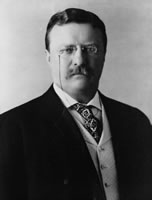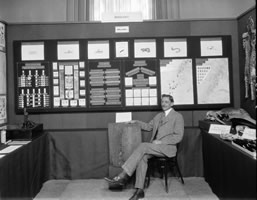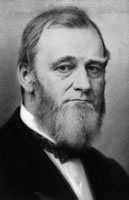by Teodora Bagarinao
Washington DC, 16 October 2007. One hundred years ago today was a Wednesday, the day the United States Steamer Albatross left San Francisco on her way to Manila to begin the two-year long Philippine Expedition. Assistant Curator Paul Bartsch of the Smithsonian Institution recorded the scene in his journal:
“There is scarcely any indication of a breeze this morning, and the swells are scarcely broken by a ripple. The sun is struggling bravely to disperse the fog which obscures the greater front of the shoreline of the bay. Numerous merchant ships and smaller craft crowd the wafts [sic] and the regular ferries between San Francisco, Sausalito, and Oakland are plying back and forth. Two large government boats lie at anchor at a little distance from our vessel and our launch seems impatient to be off to shore for her last trip before we lift anchor and depart. Numerous … gulls are beating back and forth watching the vessels for discards from the cook’s pantry. All is cheerful and if present indications augur well we should have a most successful and enjoyable expedition”.
At the helm was Lt. Commander Marbury Johnston of the US Navy. The director of the expedition was Hugh McCormick Smith, then Deputy Commissioner of the US Bureau of Fisheries. To Smith fell the task of organizing the expedition: planning the itinerary, negotiating with the island government, gathering the equipment, and selecting the civilian crew. Frederic M. Chamberlain, Lewis Radcliffe, Harry C. Fassett, and Clarence E. Wells from the Bureau of Fisheries, and Paul Bartsch boarded the Albatross in San Francisco. The Albatross spent 10 days in Honolulu, two days in Midway, two days in Guam, and on 28 November 1907, she steamed into Manila Bay. Smith had traveled separately to Japan, and joined the Albatross in Manila on 3 December, along with the Japanese artist-illustrator, Kumataro Ito. While waiting for delayed equipment, Smith and Bartsch spent nearly two months exploring the interior of Luzon and even climbed up to Baguio.
In 1907, the Albatross was already 25 years old, having been built in 1882 at the instigation of Spencer Fullerton Baird, ornithologist and second Secretary of the Smithsonian (1878-1887) who founded the US Commission of Fish and Fisheries in1871 and served as its First Commissioner until his death in 1887. It was Baird who submitted the proposal for the Albatross to the US Congress and persistently lobbied for funding until he got a total allocation of $190,000 (a huge amount in 1880!) to build it. The iron-hulled Albatross was the world’s first large civilian vessel especially designed for deep-sea oceanographic and fisheries research. Propelled by twin screws made of wrought iron, it could go 10 knots, was 70 meters long and 8 meters wide, had two spacious laboratories, two powerful dredging engines, and carried 8,100 meter of steel rope. It was also the first US government ship with electrical lighting. Although owned by the Bureau of Fisheries, the Albatross was run by a crew of about 60 officers and enlisted men of the US Navy.
All this information has been easy to come by via the internet and various publications by the Bureau of Fisheries and the Smithsonian. Government records are very well kept in the United States. I actually handled the original US Navy deck logs of the Albatross, now at the National Archives, and the original Bureau of Fisheries Albatross log books, now at the Smithsonian Archives. It was so exciting to be transported a century back in time and imagine being on the Albatross. It was fortunate that the Philippine expedition happened at all. A period of relative peace seems to have followed the establishment of a civilian government in the Philippines after President Theodore Roosevelt declared the Philippine-American War over on 4 July 1902.
 |
| President Theodore Roosevelt |
Because of our first names, I feel an affinity for Theodore Roosevelt and was happy to learn that he was very interested in the Philippines. As Assistant Secretary of the Navy, he strongly urged then President William McKinley to take the Philippines from Spain in 1898, partly to save it from Germany and Japan. It was Roosevelt who chose Commodore George Dewey to command the Pacific fleet and it was him who ordered Dewey to engage the Spanish Armada in Manila Bay in May 1898. Dewey won in a few hours. Roosevelt actually wanted to be the Governor of the Philippines, but was persuaded to become Vice-President to McKinley when the latter ran for reelection. Roosevelt became President when McKinley was assassinated in 1901 and won the election himself in 1904 to serve until 1909. He was the youngest ever to become US President, and he was a man of many talents and great achievements. He kept an eye on the Philippines the whole time, and even proclaimed several of the country’s earliest national parks, including Mt. Makiling in 1903. Even as Roosevelt sought to build an American empire, he also tried to bring the benefits of freedom and democracy to the Philippines. I was very pleased to witness two weeks ago the centennial celebration (with reenactment) of the laying of the foundation stone of the Washington National Cathedral on 29 September 1907, an event attended by Roosevelt himself. The Washington National Cathedral is a most beautiful and uplifting place and I now consider it my favorite church, partly because of Roosevelt.
 |
|
| Paul Bartsch, Curator, Division of Mollusks, at the Conference on the Future of the Smithsonian, February 11, 1927. Photo from Smithsonian Archives. | |
 |
 |
| Spencer Fullerton Baird, sponsor of the USS Albatross | Hugh McCormick Smith, Director of the Philippine Expedition |
When I was young, I hated history because in all my classes, it was taught as names, places, and dates, without a story. (Ambeth Ocampo came around too late for many of us.) History was a burden and a bore. But call it menopause, history now fascinates me, to the extent that when I come back next year, I will mine my 73-yr old mother for her life and times. Right now, within sight from my Constitution Avenue bus stop, are the US National Archives, the Smithsonian Institution, the Capitol, and the Library of Congress—history in my face every day! Incredibly, October is Filipino-American Heritage Month and National Genealogy Month at the National Archives. Last Tuesday, 2 October, at 11 AM, there was a lecture, Governing the Philippines: Records of the Department of the Interior, 1898-1971, an overview of the records of the two US agencies that administered the Philippines—the Bureau of Insular Affairs and the Office of Territories. I did not know about that lecture until today, but I will be working at the Archives the next two weeks, and who knows what I find.
Philippine history has been poorly written about in textbooks, including versions that have been lambasted for errors or bias in facts and interpretation. I choose to go by Stanley Karnow’s (1989) Pulitzer Prize winner, In Our Image—America’s Empire in the Philippines. I bought a hard cover of this book in San Diego when it came out, but I never read it because I saw the TV version of it on Public Broadcasting Station. That PBS documentary was too much Cory Aquino, but the book (I had to get a used paperback last month) is so much more, and very engrossing, as good stories are. Karnow is a journalist and knows how to write and tell non-fiction; I recommend In Our Image to all senior citizens at SEAFDEC/AQD. I read Karnow to get a feel for life, politics, and war in the Philippines and the United States at the beginning of a bittersweet “parent-child” relationship, and just before the USS Albatross expedition in 1907-1910. Karnow makes no mention of the USS Albatross at all—I am sure he intended me to tell that story! More next month.
__________
 Dr. Teodora Uy Bagarinao is affiliated with the Southeast Asian Fisheries Development Center (SEAFDEC) in Tigbauan, Iloilo, Philippines. She is now conducting a Fulbright-funded research project at the Smithsonian Institution’s National Museum of Natural History in Washington DC entitled “The USS Albatross Philippine Expedition of 1907-1910: biodiversity collections, research publications, and exploration history”.
Dr. Teodora Uy Bagarinao is affiliated with the Southeast Asian Fisheries Development Center (SEAFDEC) in Tigbauan, Iloilo, Philippines. She is now conducting a Fulbright-funded research project at the Smithsonian Institution’s National Museum of Natural History in Washington DC entitled “The USS Albatross Philippine Expedition of 1907-1910: biodiversity collections, research publications, and exploration history”.
Dr. Bagarinao obtained her Ph.D. (Marine Biology) from the Scripps Institution of Oceanography, University of California, San Diego in 1991 on fellowship from the Fulbright-Hayes Foundation (USA), her M.Sc. (Marine Biology) from the same institute in 1982 on fellowship from the International Development Research Centre (Canada), and her B.Sc. (Biology), magna cum laude, from the University of San Carlos in 1977.